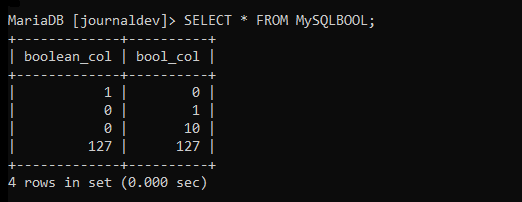

It uses integer values 1 and 0 respectively for true and false. All of the unticked boxes are defaulted to 0 as per your migration. MySQL doesnt support true booleans as per standard SQL. TINYINT(M) UNSIGNED ZEROFILL A very small integer. Before 5.0.3, BIT is a synonym for TINYINT(1). This data type was added in MySQL 5.0.3 for MyISAM, and extended in 5.0.5 to MEMORY, InnoDB, BDB, and NDBCLUSTER. This way, when the title checkbox is ticked, your $request->all() returns an array containing an item 'title' => '1' and this is saved in your database. M indicates the number of bits per value, from 1 to 64. I have the following controller method that runs when the form in the frontEnd is submitted: public function store(CreateArticleRequest $request) In general, any MySQL data type can be converted to a, and any numeric type can be converted to any of the Java numeric types, although round-off, overflow, or loss of precision may occur. What is the purpose of NULL value in boolean type column? Is it "all", "any", or "no"? The null value in boolean column allows us to use the unique index, but it also messes up how we interpret the records.I have made the following migration in Laravel: increments('id') MySQL Connector/J is flexible in the way it handles conversions between MySQL data types and Java data types.

So you may though "Okay, but you can use NULL value since these are ommited by unique index checks", and yes this is truth, but we are loosing linguistic rules here. Since the product can have only one cover we need to add a unique index on these two columns.īut wait, if these two column will get an unique index how would you store many non-cover images for the same product? The unique index would throw an error here. So far out product_image table has two columns: product_id and is_coverĬool? Not yet. bool, boolean, bit(1) boolean Boolean System.Boolean tinyint sbyte SByte System.SByte tinyint unsigned tinyint Byte System.Byte smallint, year smallint Int16 System.Int16 int, integer, smallint unsigned, mediumint int Int32 System. How do you know which photo serves as a product cover? Well, we would use a column that indicates it. You can learn more about them here: MySQL BIT data type explained MySQL ENUM data type explained The TINYINT is the default alias for BOOLEAN type as defined by MySQL, but. Aside from the TINYINT type, MySQL administrators may also use either the BIT or ENUM type for storing boolean values. Whenever you choose int or bool it matters especially when nullable column comes into play. And that’s how the BOOLEAN type is used in MySQL. But at a practical level, it really doesn't matter - they both do the same thing, so you're not gaining or losing anything by using either. Personally I would suggest use tinyint as a preference, because boolean doesn't do what you think it does from the name, so it makes for potentially misleading code.

The last two statements display the results shown because 2 is equal Mysql> SELECT IF(2 = FALSE, 'true', 'false') Mysql> SELECT IF(2 = TRUE, 'true', 'false') Mysql> SELECT IF(1 = TRUE, 'true', 'false') These mappings make it easier to import table definitions from other database systems into MySQL.

However, the values TRUE and FALSE are merely aliases for 1 and 0, respectively, as shown here: mysql> SELECT IF(0 = FALSE, 'true', 'false') Nonzero values are considered true: mysql> SELECT IF(0, 'true', 'false') See the quotes and examples down below from the /doc/īOOL, BOOLEAN These types are synonyms for TINYINT(1). Boolean isn't a distinct datatype in MySQL it's just a synonym for tinyint.


 0 kommentar(er)
0 kommentar(er)
